Why did the chicken cross the road? We’ll likely never find out. But if you type this into a search engine, I’m pretty sure I can predict what the top results might return. Not only because I’ve searched for this myself, but also because of something called search intent, which basically means that search engines are trying to give you what you want by first understanding (or guessing) what it is exactly that you want and – more importantly – why you want it.
If you understand what your users want and what their intent is when they are searching for a specific query, half of the job for ranking on that keyword is done. Of course, there is still a lot of work to do (like knowing what are the 3 types of intent and what type of content to write for each type of keyword and search intent). The good news is that this article will let you know everything you need to know about search intent, from A to Z: from how to understand user intent to how to best optimize for it and rank to the top for the keywords that interest you most.
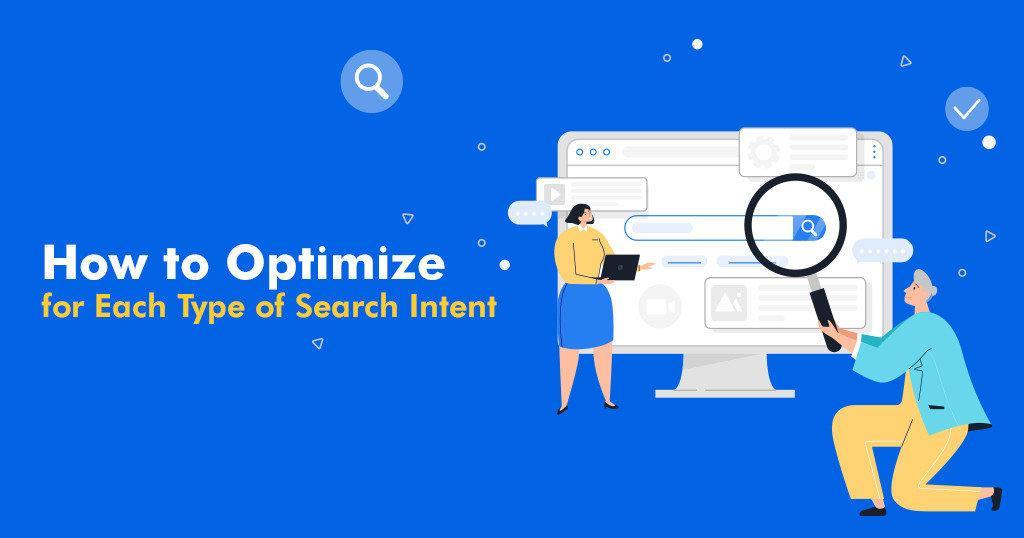
- What Is Search Intent?
- What Is User Intent in SEO?
- What Are the Types of Search Intent?
- How to Optimize for Each Type of Search Intent
- Why & How to Optimize for Informational Search Intent
- How to Optimize for Navigational Search Intent
- How to Optimize for Transactional Search Intent
- The Challenge of Matching Search Intent
- What Type of Search Intent Should You Start Optimizing For
1. What Is Search Intent?
Search intent or keyword intent is the reason why people conduct a specific search. Why are they searching? What are they trying to achieve through their search?
Are they trying to figure out the answer to a question or do they want to reach a specific website?
Over the years, Google has become more and more able to determine the search intent of people. The whole Google SERP now is trying to best fit the search intent and not the exact searched keyword. There are situations when the exact searched term is not even included in the Google search results page. And this happens because Google has become better and better at determining the search intent of people.
Google wants to rank high the pages that best fit the user’s search intent. And lately, it has managed to do that pretty well.
Going back to the riddle from the beginning of the article, it’s true that we might not find out why did the chicken cross the road; yet, what we will find out (if you haven’t googled it already) is what this riddle is all about. And we’ll get videos about it and even a featured snippet explaining what’s all about. And this happens because the search engine understands my intent when searching for this query.
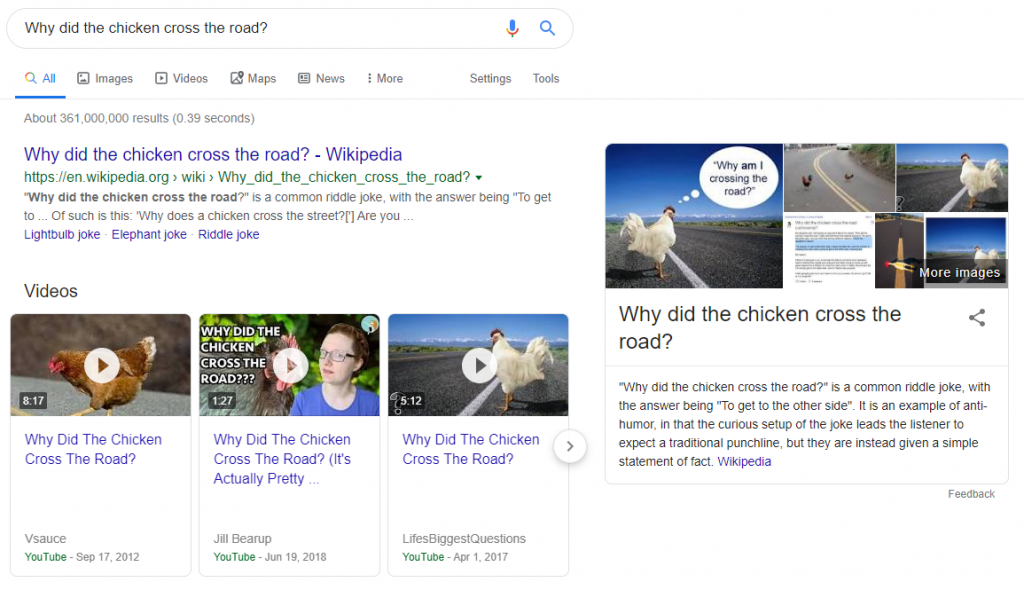
2. What Is User Intent in SEO?
User intent to SEO is like a moth to a flame.
Putting it simple, if you want to rank high in Google, you have to offer content that best fits the users’ search intent. If you’re not able to do so, chances are that you’ll not be able to be on Google’s hall of fame, meaning its first page of search results.
There are about 3.5 billion searches per day. And according to statistics, a searcher uses around 3 words in a search query.
Google has to figure out what exactly do they want, so it can offer them the search engine page results they need. And your job is to create content that is relevant to the Google users and matches their search intent.
3. What Are the Types of Search Intent?
Let’s say, for instance, that your search is related to sunglasses. Based on the keywords you use, the search engine might interpret your query as having different intents behind it:
- informational (if you search for “sunglasses polarized meaning”);
- navigational (if you search for the name of a particular brand of sunglasses);
- transactional (if you search for “cheap sunglasses” or “buy sunglasses”);
If you’re wondering which search intent is the most popular, you need to know that studies showed that more than 80% of the total search intents are informational, 20% being almost equally split between navigational and transactional.
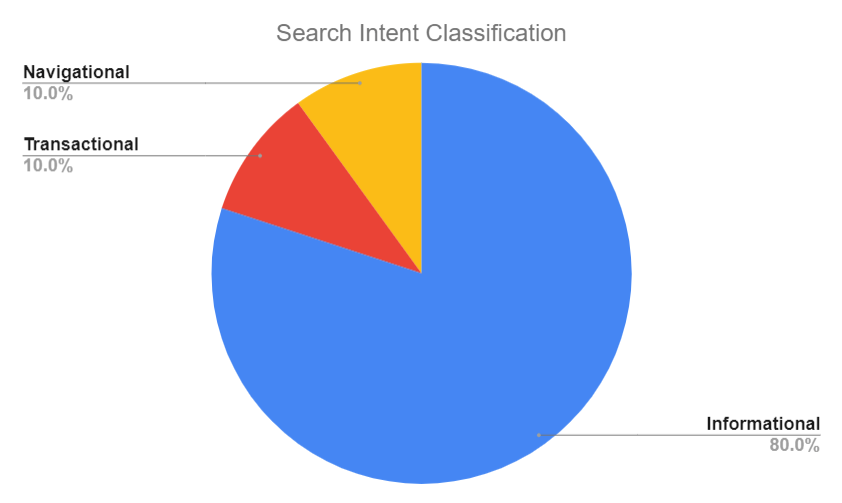
The concept of search intent was first coded way back in 2002 by Andrei Broder, and consisted of the first 3 categories illustrated above. These 3 categories also seem to be matching Google’s quality guidelines on understanding different types of queries. They call them:
- Know (informational),
- Do (transactional),
- Go (navigational).
By now you might be thinking: OK; that’s great. But how will I recognize a type of search intent when I see it?
In the following lines, I’ll highlight the characteristics of each type of search intent so you can better understand them.
Wouldn’t be great if there was a tool that automatically classifies the search intent for you?
Did you know?
The Content Optimizer & Keyword Tool from cognitiveSEO automatically classifies the search intent for you.
You just need to type in the keyword you are interested in optimizing for, and the tool does most of the job for you. The tool performs keyword research, it will tell you what is the user search intent, how popular is that keyword, how difficult it is to rank on it, and cream of the crop: what it takes to rank on that keyword, meaning, what are the exact keywords and links that boosted that page in the top of the search results.
4. How to Optimize for Each Type of Search Intent
Even if most of the searches have an informational intent, we believe that all three categories of search intent need your attention as they can be seen as a cycle in the buyer’s decision and not individual searches. And that’s why it’s very important to understand how to tackle each type of internet search and how to best optimize your content for them.
5. Why & How to Optimize for Informational Search Intent
Informational search queries are queries that cover a broad topic for which there may be thousands of relevant results: how tall Jennifer Aniston is, how to peel a pomegranate, steps to apply mascara, etc. Aside from these questions, the main question is how to make your website stand out and respond to the user’s need.
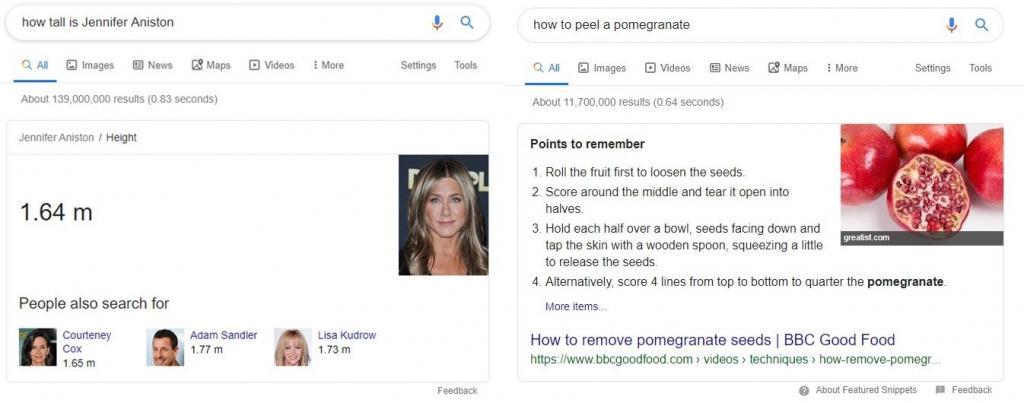
You might say that informational queries are hard to monetize so, what’s the point in optimizing for them?
While that remains true, optimizing for them is totally worth it. Google has a “special treatment” for these types of queries: Featured Snippets (also known as answer boxes, knowledge graphs or Google direct answers). If you’re searching for something like “how many calories does an apple have”, you’ll get a direct answer, highlighted within a box, just like in the examples below. We did a really cool research on answer boxes a while ago; you should check it out.
Being on the Google’s answer box will do you a big favor, making you appear on Google’s first page not once, but twice.
So it’s not just showing up in the results, it’s showing up in the answer box, which has a different status in the mind of the searcher. For more info on answer boxes, you can check out this research we performed some time ago.
Now that we hope we’ve convinced you of the importance of optimizing for informational search queries, here are some tips on how to do it.
Most of the time, informational search queries contain question words like:
- How can I
- What is
- How to
- What are the benefits of
- How do/does
- Ways to
- Guide
- Tutorial
This means that your content has to answer these questions, requirements the searcher has. The question remains: how should your content look like to make sure your content is optimized for these type of search queries?
5.1 What Type of Content Do You Need to Create for Informational Queries?
The users want to “know” something so they will use words that will help them learn more about a topic.
The “formula” you should target is informational query + your industry term.
Let’s take the sunglasses niche for instance; in this case, you might want to optimize for “what are the benefits of sunglasses” or “how to clean sunglasses”. You have the informational query (what are, how to, what is, etc) + your industry term (in our case, sunglasses).
Below you can see a screenshot on how the Google SERP looks like for the “what are the benefits of sunglasses” query. As you can see, the very first result, on position zero is a direct answer with a list of benefits wearing sunglasses have. That piece of content responds directly to the user search intent; as you can see in the screenshot below, on the right side there is the website. Its content is simple, yet it responds perfectly to the user’s need.
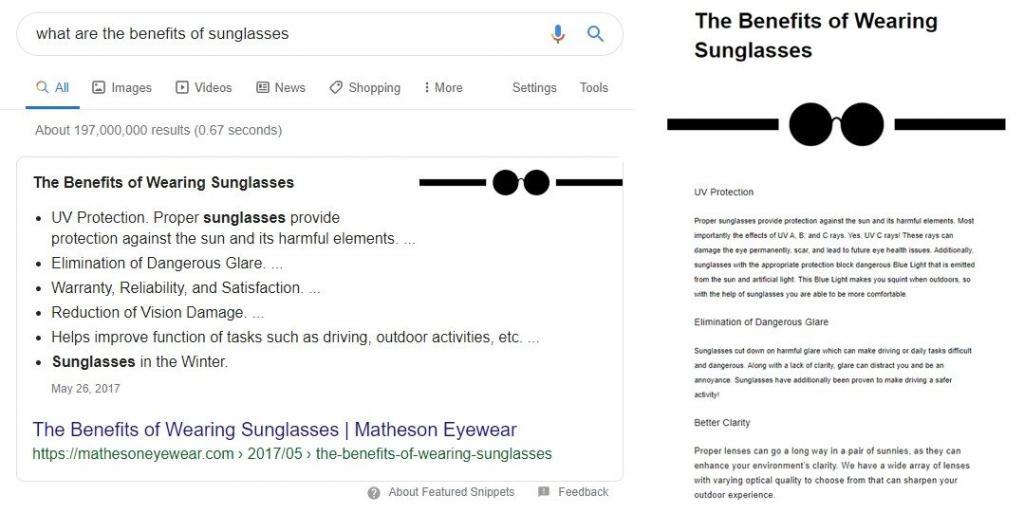
You need to create content that meets the user’s need and will also rank high on Google.
The most effective content types for informational search intent should include:
- blog posts with tips, lists
- how-to videos
- infographics
- step by step guides
- checklists
Your main goal should be to create high-quality content that is useful and provides helpful information relevant to the query. Keep in mind that the users want hands-on info and direct answers. And through the content you create you can both meet your users’ needs plus drive traffic and leads to your site. To have added value, create content optimized for search intent.
5.2 How to Create Relevant Content for the Informational Keyword Intent
Step 1. Perform a quick Google SERP analysis
Every keyword research or content optimization process should start with a SERP analysis together with competitor analysis. The Ranking Analysis from the Content Optimizer Tool gives you tons of insights related to the analyzed keyword. Quick and easy, you get to know the search volumes, what type of content ranks on that keyword, how difficult it is to rank on that query (by following keyword difficulty), as well as how popular that keyword is among searchers. Also, the tool lets you know the exact keywords and links that boosted that page in the top Google results to easily optimize your content.
Step 2. Create relevant & optimized content
Remember when I told you that the Content Optimizer does most of the job for you? I know I’m biased and I don’t want to praise the tool too much, but the reality is that it does most of the job for you. Once you performed the ranking analysis, what you need to do is start writing a new piece of content or optimize the existing one and the Content Assistant will let you know the exact keywords you need to use so your content will be relevant for the informational search intent.
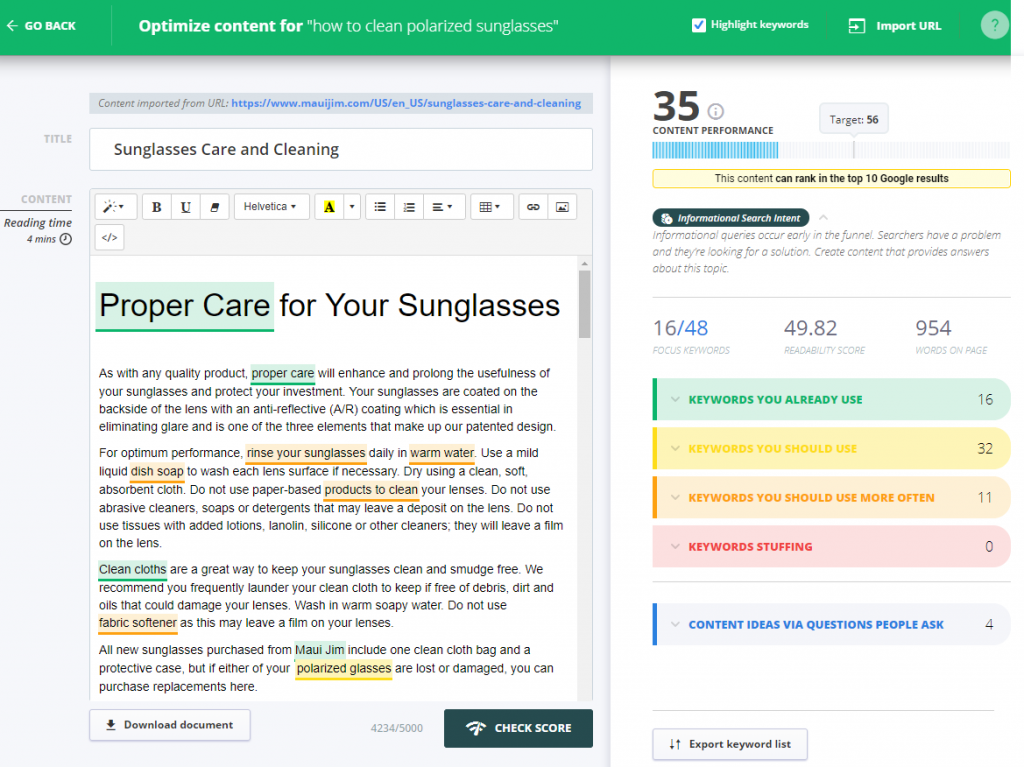
Step 3. Get new keywords & rankings opportunities
You can also use the cognitiveSEO Content Optimizer to discover other queries that your users might be interested in. Searchers have more than one question when it comes to products from your business. Take the opportunity and offer them relevant content for most of their questions. You can use the same Content Optimizer for this task. The tool has two sections that will automatically let you know what other questions are related to your search query:
The Keyword Explorer – this section is great for keyword analysis and discovering new keyword opportunities. It also gives you the possibility of seeing only the question suggestions. Get inspired by the list of questions, check out the relevancy of the question, its volume, CPC (cost per click), and choose the one that is the most suitable and profitable.
The People Also Ask section – the Content Assistant will let you know the exact keywords you should use in your content, what are people searching, but it will also offer you a set of questions that relate to your original search query. You should consider answering these questions in your content or create new content starting from these questions.
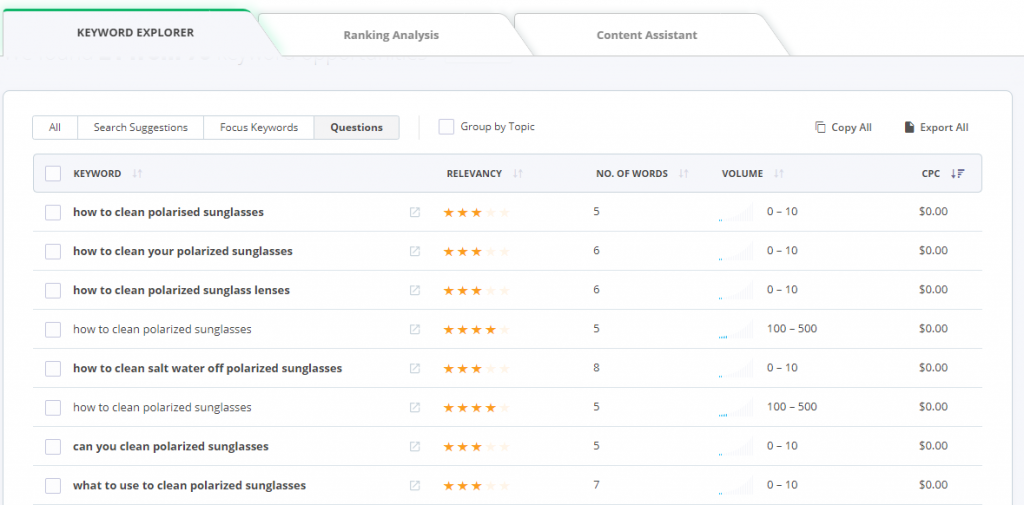
By being a topical authority in your niche, you’ll boost not only your brand awareness but your ranks as well. As mentioned above, back in 2007, which we know is a lot of time in the years of the Internet, a very interesting study suggested that from a total of one million analyzed queries, 80% were informational. That’s an impressive percentage. And even if time has passed by and user’s search queries types might have changed, it is clear that the informational search is the most common type of search.
6. How to Optimize for Navigational Search Intent
With a navigational query, the user is looking to reach a particular website or product/service that they already know about. In this case, there is probably only one likely website that they’re looking to reach.
Most likely the user is searching for brand terms or names of products or services already known: facebook login, amazon, adidas, etc. You might be thinking why is this a search and why isn’t the user accessing the website directly? One reason could be that the user doesn’t know the exact brand or because it’s easier to type “youtube” within the search bar, instead of typing the whole URL.
For the cases when the user is not accessing the URL directly, you need to know that navigational search queries include:
- Brand name
- Service/Product name
- Brand Login
- Reviews
- Location of
- Directions to
- Near me
- Hours of
- Cost of
- Testimonials
Once again, you might be thinking what’s the point in optimizing for these types of queries since the user knows exactly what they’re searching for and Google will list the brand name searched by the user to the very top of the SERP.
While it’s true that you don’t stand much of a chance targeting a navigational query (unless you happen to own the site that the person is looking for), there might be some room for optimizing for navigational queries.
6.1 What Type of Content Do You Need for Navigational Queries?
The “formula” you should target is your own brand name or navigational search query + brand name.
for example: Ray Ban Sunglasses, Ray Ban Sunglasses Presentation Video, etc.
To make sure you meet your user’s needs, these types of content should be suitable when it comes to navigational search intent:
- Clear landing pages and online forms
- Product demo videos
- Case studies
- E-books
- Presentation pages
- Product and service lists
- Webinars
- or any type of content that relates to your navigational keywords
Let’s take the search “brand mentions”, for instance. As the Content Optimizer already tells us, this is a navigational query, as the user might want to access brandmentions.com. Yet, as you can see in the search results, there are many other pages that are ranking well for this query by targeting “brand mentions” as a topic users might want to find more about.
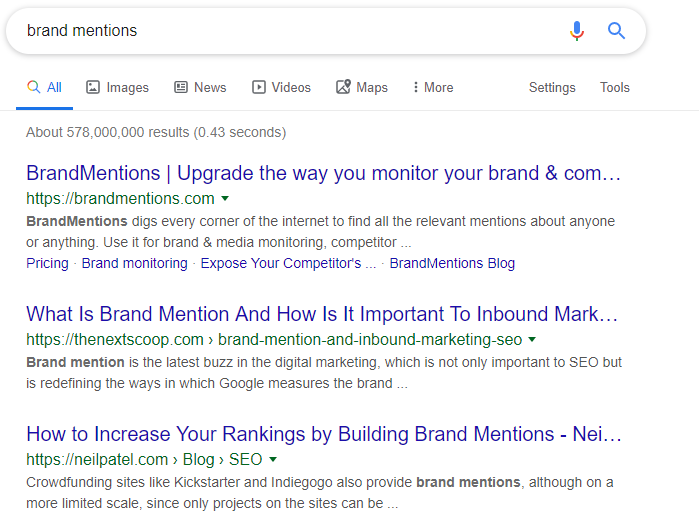
Just by taking a look at the SERP analysis you can easily understand how the whole picture look like for this query. And while you won’t be able to overthrow the main brand ranking for its brand name, you might find yourself a place on the first page.

Another important aspect here: make sure you own your own brand’s navigational query. Although it sounds surreal, there might be situations where the brand itself is not ranking first for their navigational query. Also, make sure you optimize for all “versions” of your brand (different spelling, common typos, brand name adjustments in different countries, etc.)
Furthermore, we mentioned above that the search intent types must be seen more as a cycle than an individual search. And here’s what we’re talking about: remaining in the sunglasses area, if someone, by searching “how to clean sunglasses” found a specific product that helps with the cleaning (let’s say Windex), most likely they will search for Windex.
Therefore, it may happen that an informational search will be followed by a navigational one.
6.2 How to Create Relevant Content for the Navigational Keyword Intent
As mentioned before, as you might say that you don’t stand much of a chance targeting a navigational query (unless you happen to own the site that the person is looking for), there is still room for improvement. Therefore, we recommend you to follow these steps to create relevant and optimize content. (the steps are elaborated above).
7. How to Optimize for Transactional Search Intent
With a transactional search query the users are looking to buy a product; are connected to commercial intents. This is a query that indicates an intent to complete a transaction, such as making a purchase, finding a place to make a purchase, or completing a task. For example: iphone x, where to buy Saeco coffee machine, Metallica tickets for sale, etc.
To get to pages where they can make a purchase, searchers use buyer or transactional intent keywords that can include:
- Buy
- Where to buy
- Discount
- Apply
- Purchase
- Coupons
- Schedule appointment
- Reserve
- Deals
- For sale
- Order
- Download
7.1 What Type of Content Do You Need for Transactional Queries?
As these are exactly the kind of queries that are mostly likely to deliver ROI in search (organic or paid), you need to know what type of content you should write for transactional search queries.
The formula you should target should be: transactional keywords + brand/product/service name/industry terms.
for example: discount ray ban sunglasses or where to buy ray ban sunglasses.
You can easily target transactional queries with many types of optimized content or even blog posts or pages optimized for local SEO.
We recommend you should consider optimizing these types of content for your transactional queries:
- Product pages
- Pricing pages
- Sign up pages
- Live demos
- Appointments pages
- Free consultations
- Sales pages
Now more than ever, Google is focused on offering a personalized experience for each user and their search intent, thus local optimization plays a crucial part in the play. When it comes to transactional search intent, you might want to keep in mind that local optimization is highly important. People are looking for places to buy things, they want to schedule appointments so being there, in the top results when they are searching for suck queries is what interest you.
Therefore, try optimizing as well at a local level. The same Content Optimizer can be used for precise locations so choose the exact location you want to rank on, and see what it takes to rank be in top Google results.

Of course, offering relevant & optimized content at a local level is just one of the strategies when it comes to transactional search intents. Perform SERP analysis and check what your competitors are doing. See what it take to rank on the top and understand the user’s need.
7.2 How to Create Relevant Content for the Transactional Keyword Intent
keep in mind that In this stage of user intent – transactional search queries – the user is ready to buy, is ready to take action. And most of the search results that show up with this query are from online stores that are selling the product the consumer wants to buy. Make sure that your existing content supports user intent. What you will need here will be product pages. Analyze your competitors, see what it took for them to rank and follow the three steps of creating relevant content for the transactional keyword intent.
8. The Challenge of Matching Search Intent
It’s important to keep in mind that search intent is not static. Think about searching for “amazon” – 9 times out of 10, this will probably be navigational, but during the past week or two, quite a few of the searches may have been informational, an effort to better understand news snippets or social media posts about wildfires in the Amazonian forest.
SERP answer boxes also seem tailored to the intent – you might get a definition for an informational query and a list of shopping pages for a transactional query. If there is a “people have also asked” section on display, it will make it even clearer how Google, for instance, interprets the intent for a particular keyword.
Some keywords tend to be associated more consistently with a given intent than others.
It’s likely that “facebook”, for instance, will always be associated with the social network and, on its own, will always have a mainly navigational intent behind it. Other keywords, however, tend not to be consistently associated with a singular intent. This can be exactly the kind of opportunity that might appeal to someone who is working in the SEO industry.
If the keywords you want to rank for have clear and consistent intent behind them, you can tailor your content format and structure to be the best possible match for that intent.
A search for “how to make tiramisu” already has the clue in the title – it’s likely going to be a “how to” type of article that’s going to draw attention and given the context, a blog is probably the best type of page to host this content. On the other hand, with a search like “iphone 10 vs samsung galaxy 10”, you would fully expect for the first page of results to be filled with comparative review type pages from specialized review websites.
But aside from the format and structure of the page holding the content, there might also be an “angle” to it, which is similar to the USP (unique selling proposition) in marketing.
You might be looking for how to make tiramisu, but wouldn’t you prefer to know how to make the best one? or the most original one? Sure, you’re looking for headphones, but are you interested in the best quality headphones or the cheapest headphones? And the list goes on.
When it comes to format and structure, you want to go with the flow and do what everybody else does, because that is what has been proven to get results (search results, to be more exact). However, when it comes to the angle, that’s your time to be original. Format and structure land you on the front page. Angle can influence which position in the rankings you’ll show at.
9. What Type of Search Intent Should You Start Optimizing For
People are no longer only following a linear path from awareness to consideration to purchase. Google revamped this mental model, adding the Zero Moment of Truth (ZMOT) which takes account of the fact that purchasing decisions are now heavily led by self-directed online research. To optimize for search intent, we need to look for what customers are trying to achieve.
Know which rules to follow and which to break.
Search intent should dictate the type of content you create.
If the keyword has informational intent, write a blog post. If it has transactional intent, create a product page. Google rankings aren’t static. They fluctuate and change over time.
Given that you’re relying on the nature of the current top-ranking pages to infer search intent, that can be a problem. Reason being, what you’re actually doing is judging search intent based on a single snapshot in time.
If you were to analyze the top-ranking pages next month, or the month after, your understanding of search intent may be different. For that reason, it also pays to constantly check your targeted keywords and constantly update your content to make it as relevant as possible.
Understanding search intent and adapting to it can yield numerous benefits. To mention just a few:
- It can reduce your bounce rates
Only the people who are interested in what you’re offering are going to land on your pages – and stay for more.This, however, does not mean reduced visits; on the contrary, you are more likely to show up further up in the rankings when there is a consistent match between the demand (the need for the searches) and the offer;
You are also likely to get a wider audience, as Google often finds matches between related types of queries, so ranking high for a series of keywords will likely open up new possibilities for related ones.
- Understand what you are offering and how it matches with the intent of the users
Firstly, you need to figure out what your page stands for – is it mostly informational or transactional? If you want both, you might have to use different formats (website and blog) and very different structuring for your posts. You should also consider how to best link the two so that, on the one hand, it’s easy to slide from one into the other, but on the other hand, Google doesn’t think you’re trying to pull a fast one on the users and offer them transactional content when all they wanted was informational content.
- Use this knowledge to look for opportunities & niches
Do research on keywords and how they are associated with intent. Try to see if the keywords you’re interested in have stable or fluctuating intent associated with them. Get really familiar with the vocabulary for a particular intent, whether it’s informational, transactional or investigative. See what other keywords might be associated with not only the same query but also the same intent. Try to identify competitor gaps, and create content that fills in those gaps. Be aware that intent can be both active and passive and it is a lot more difficult to predict passive intent. A search might not include any of the traditional words related to buying or pricing, but still hide a transactional need.
Behind every Google search, there is an intention. If you want your business to be discovered by users on the web, you need to figure out that intention. And if you find it hard to figure it out, no worries as this is why tools like the Content Optimizer exist on the market, to help you increase what matter most for your business: traffic and therefore, sales.

 Site Explorer
Site Explorer Keyword tool
Keyword tool Google Algorithm Changes
Google Algorithm Changes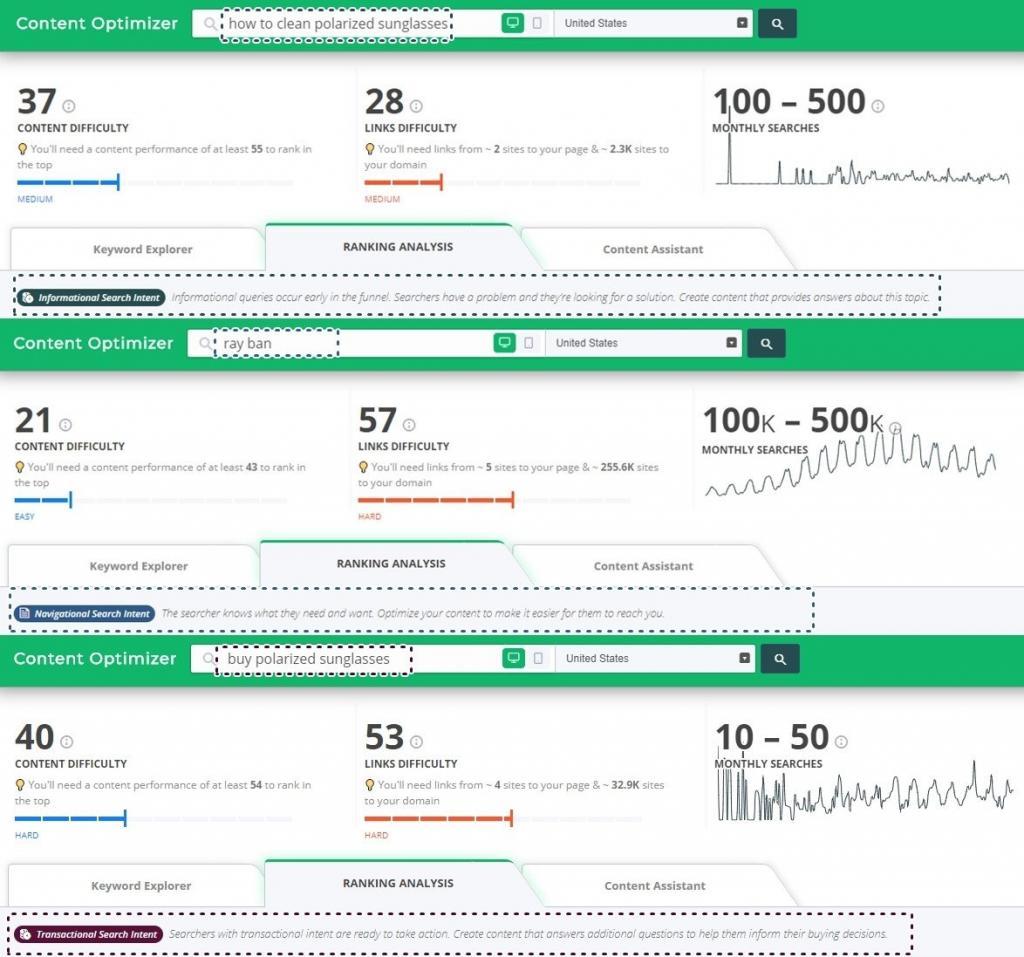



Interesting stuff to read.
This was very informative and educational for me, this year we did a large investment of our time on informational intent content. We’re trying to switch things around a bit.
Search intent is super important for all SEO and content marketers to understand. It needs to be front and center when doing keyword research and developing content strategy.
After going over a handful of the blog articles on your website, I truly appreciate your technique of writing a blog. I bookmarked it to my bookmark webpage list and will be checking back in the near future.